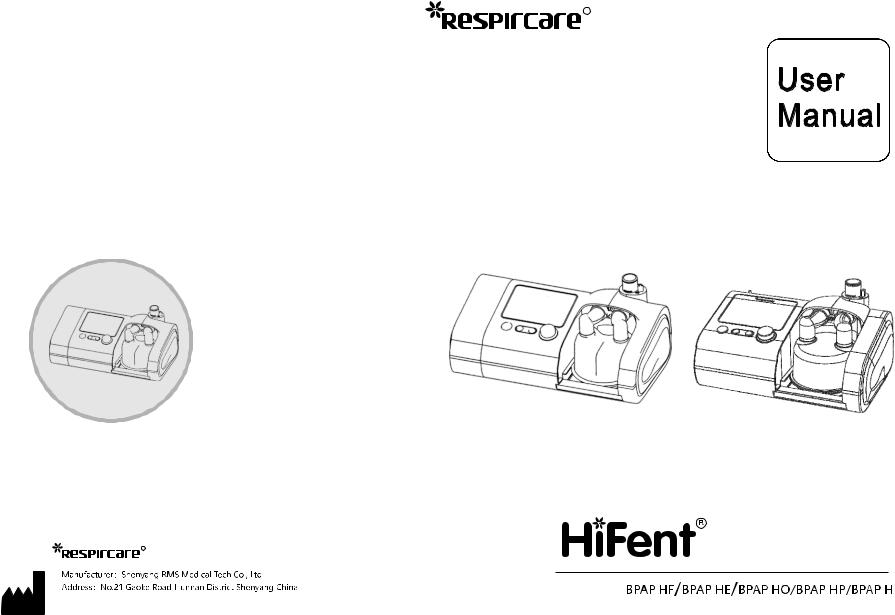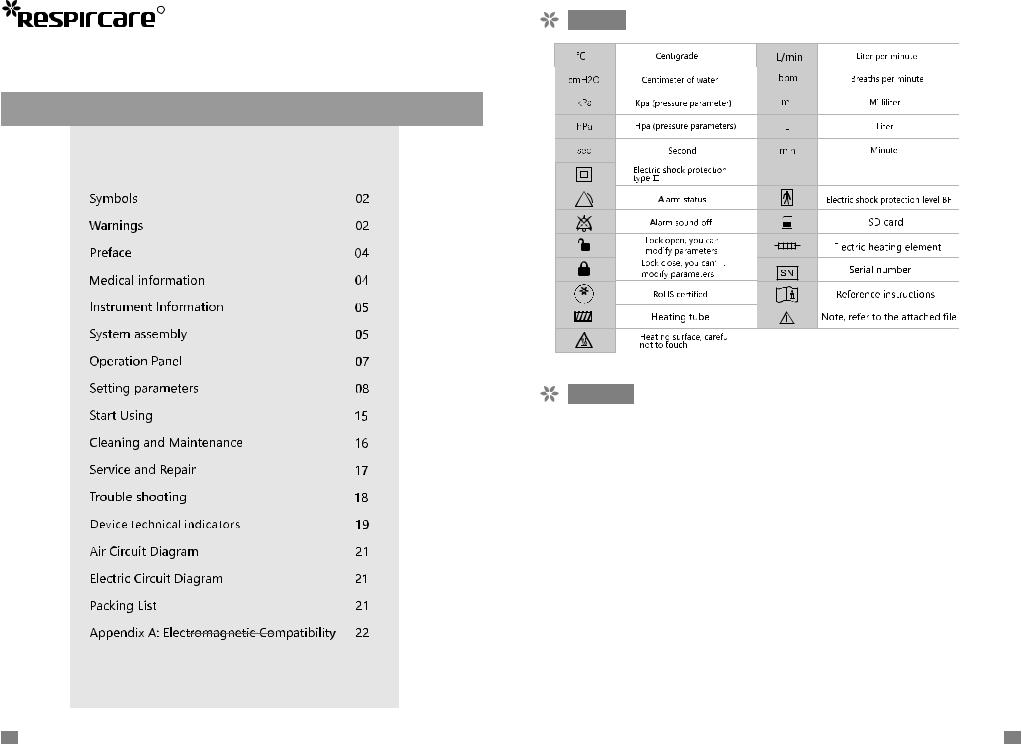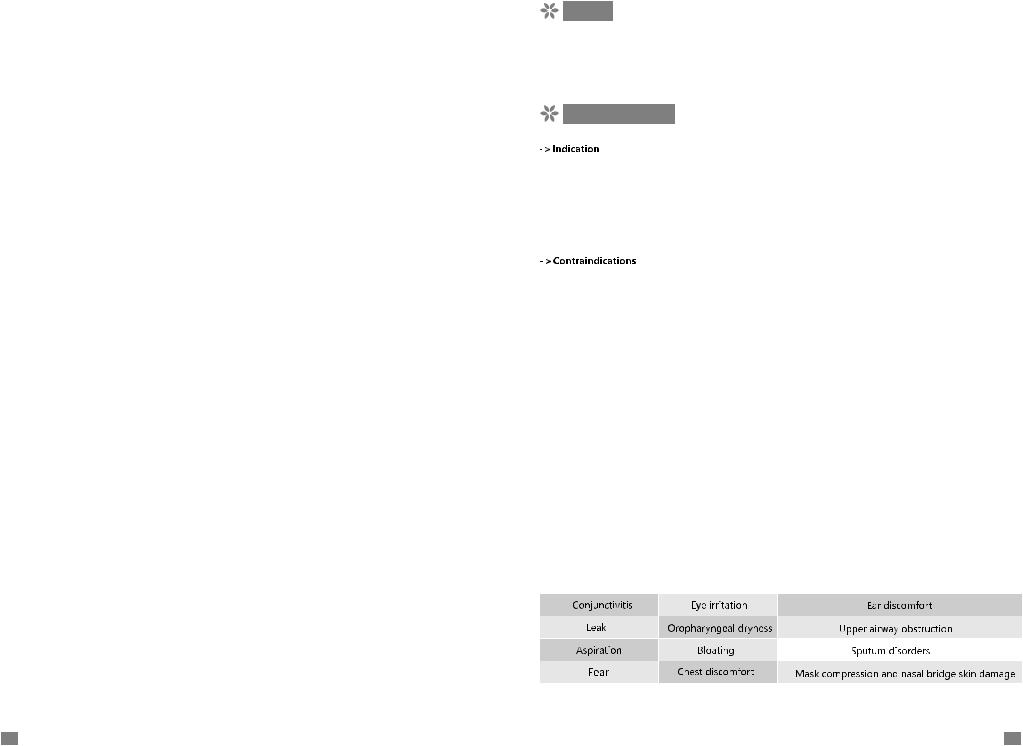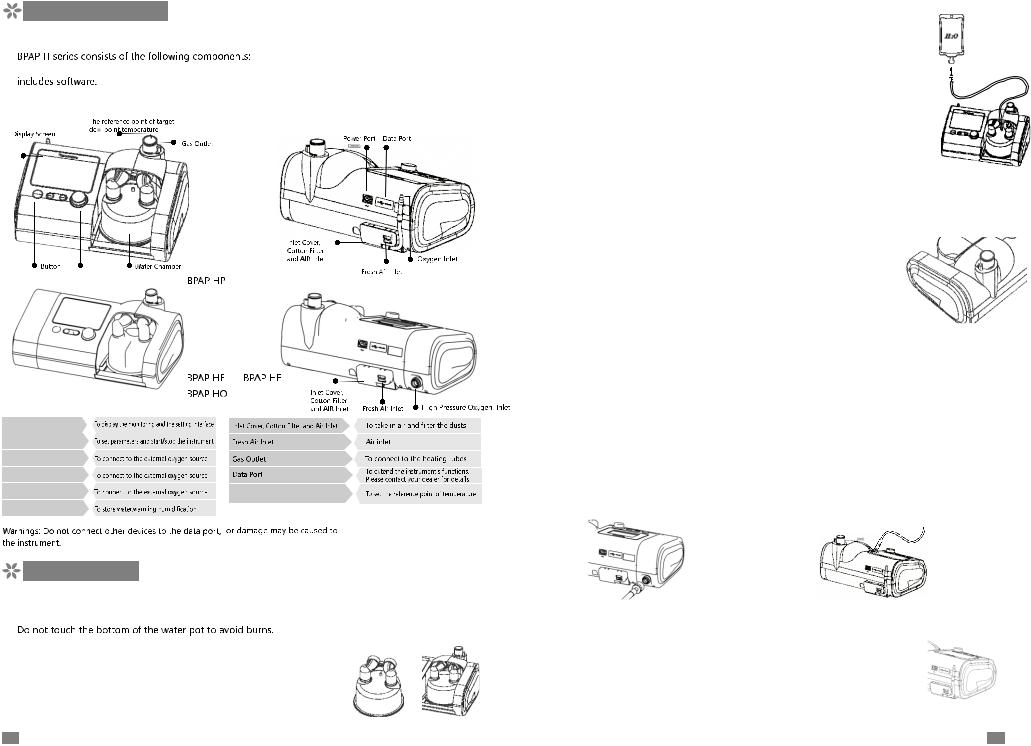HiFent BPAP HF User Manual

R
R
Tel 0086-024-31682686
233020021Rev 1.0 2020-02-17
Shenyang RMS Medical Tech Co.,Ltd
Noninvasive Ventilator

R
Symbols
C o n t e n t s
IP21 |
Ingress protection |
RoHS
Warnings
● Before using this instrument, please read the manual carefully. ● Do not use this instrument for life support.
● The instrument produces a positive airway pressure when it outputs the gas, andif positive airway pressure has side effects to the patients, it must be considered tohandle.
● This instrument must be used and set parameters under guidance of professionaldoctors. ● Do not replace doctor's advice with recommends in the manual.
● This instrument can only use water chamber, Heated breathing tube, nasal cannulasand other accessories provided by RMS Medical. Use of unapproved accessories may affect the functionality of the instrument or cause a danger.
● The water chamber, Heated breathing tube,nasal cannula and other accessoriesprovided by our instrument,it can only be used for this instrument, otherwise it mayaffect the function of other equipments or cause danger.
● In case of power failure or machine malfunction, remove the nasal cannulas andclose the oxygen input.
● To ensure its electromagnetic compatibility, this instrument must be installed,debugged and used according to provisions in attached documents.
● Portable and mobile RF communication equipment may affect this instrument'selectromagnetic compatibility. In case of such event, please contact our staff forsolutions.
● This instrument can only be connected using cables mentioned in the attacheddocument. Use of unapproved accessories and cables for connecting theinstrument may result in increased emission or reduced immunity.
01 |
02 |

●Do not place this instrument near to or stacked with other equipment. If it is necessary to place this instrument near to or stacked with other equipment, inspection and observation must be conducted to ensure that it can operate normally in such location.The instrument should be placed in a well-ventilated area and not on the soft surface.
●Do not use the instrument when it is surrounded by flammable and/or anesthetic gases.
●Stop using the instrument if it has visible external damage, a liquid has entered into the instrument or the outlet gas is over-temperature or there is abnormal noise.
●The over-use of Heated breathing tubeand nasal cannula can cause infections and other injuries.
●When the instrument is used under specified ambient temperature and humidity conditions, the temperature of outlet gas isless than 43 .
●In ventilation mode, the outlet gas may be harmful to the human body, when the room temperature exceeds 35°C.
●In humidification mode, the temperature and humidity will be affected when the ambient temperature exceeds the specified temperature range of 18 ° C ~ 28 ° C.
●When the instrument is used beyond the specified ambient conditions (temperature, humidity etc.), the instrument performance will be affected and even damaged and may cause body injuries.
●When the atmospheric pressure exceeds the specified range, using the ventilator may cause the set pressure to differ from the actual pressure
●AC input should be within ±10% of the rated voltage. AC input beyond this range may cause damage to the instrument.
●When exposed in an environment of electrocautery, electrosurgery, defibrillation, X-rays (γ-rays), infrared radiation andtransient electromagnetic fields, including magnetic resonance (MRI) and radio interference, the instrument may be interfered.
●When the instrument is blocking, covering or heating the outlet tube,air inlet port may cause overheating or even damage to the instrument.
●When the instrument is connected to oxygen,it may cause higher output oxygen concentration if the output tube is blocked.
●The ventilation holes are at the bottom of the water chamber. When moving the humidifier, do not touch the bottom to prevent body injuries.
●Pressure and differential pressure sensors are installed inside the device. Pay attention to prevent water from flowing backwards and causing damage.
●Do not move the instrument, place it upside down or tilt it when there is water in the humidification cup, so as to prevent water from flowing back into the instrument which will cause damages to the instrument. Above the humidification cup, label awarning label “Do not Tilt the Instrument When There is Water!” to have attentions.
●When the instrument is not in use, pull the plug.
●Do not open the inside of instrument,should be repaired by the authorized maintainer.
●When the treatment instrument is beyond its service life, please contact your dealer or RMS Medical for disposition instead of discarding it arbitrarily.
●Adding other components to the respiratory ventilation system will cause the exhalation pressure at the connection port of the patient to increase.
●Do not use antistatic or conductive hoses or tubes.
●The sensor's raw data collected by the ventilator is anti-interference processed by the median average filtering method.
●The high-pressure gas must be connected to medical oxygen, and fresh gas cannot be used.
●It is recommended to measure the oxygen concentration at the patient's delivery end.
●The nasal cannula, Heated breathing tube, water chamber, mask, etc. equipped with the ventilator are products registered separately by manufacturers with medical device qualifications. When using them, please refer to their own instructions.
●Note:Above mentioned are general warnings and precautions.Detailed special warnings,notes and remarks are shown in the manual.
Preface
BPAP H series ventilator is a breathing ventilation device that can use both non-invasivemask ventilation and high-flow humidified airflow. Please read and understand thismanual carefully before use.
The non-invasive ventilator must be set and used for treatment parameters under theguidance of a professional doctor.
Medical information
This product's non-invasive positive pressure ventilation mode (Ventilation mode for short) can be used for adult patients with insufficiency of breathing, such as those who do not rely on invasive ventilation support, to provide ventilation assistance and respiratory support; has a high-flow heating and humidification mode (high flow mode for short) The product can be usedfor humidification and oxygen therapy in adults with spontaneous breathing.
This product is not intended for life support, can be used in home environments, and can also be used in medical institutions. This product needs to be used under the guidance of a professional doctor.
Heartbeat or breathing stops;
Weak spontaneous breathing and coma;
High risk of aspiration, inability to remove oropharyngeal and upper respiratory secretions,and poor respiratory protection;
Combined with other organ failure (unstable hemodynamic indicators, unstable arrhythmia,perforation
/hemorrhage of digestive tract, severe brain disease, etc.)
Undrained pneumothorax;
Neck and facial trauma, burns and deformities;
Recent face, neck, oral cavity, pharyngeal cavity, esophagus and stomach surgery;
upper airway obstruction;
Obviously uncooperative or extremely nervous;
Severe hypoxemia (PaO2 <45mmHg), severe acidosis (pH ≤7.20);
severe infection;
Airway secretions or sputum disorders;
Not recommended by other clinicians.
Note: It is a relative contraindication. In such patients, the pros and cons of NPPV (non-invasivepositive pressure ventilation) need to be carefully weighed, then decide whether to apply NPPV;
->Adverse reactions
If the patient has abnormal chest pain, dyspnea or severe headache or other adverse reactions,please contact the clinician immediately.
During the use of the ventilator, the following adverse reactions may occur:
03 |
04 |

Instrument Information
->Instrument Components
Instrument.Water chamber.Heated breathing tube.mask or nasal cannula. The instrument
->Components and Functions
Display screen
Buttons
High Pressure Oxygen Inlet
Oxygen Inlet
Power Port
Water Chamber
/ BPAP H
/
Water Chamber for dew-poit and reference point of temperature
System Assembly
! Warnings: when the Water chamber and Heated breathing tube are not installed well, do not open the 
Fill Water chamber
Depress the hand guard to insert the Water chamber into the instrument, making it closely connected tothe instrument's interfaces, and then, the hand guardis rebounded back into place.
05
->Connect the water bag
Hang sterile water bag onto the instrument's high position whenuse the Water chamber, insert the inlet needle into the rubber plug of water bag, and open the bag's vents. The Water chamber will be added with water automaticallyaccording to a fixed level.
->Warnings:
Please use a medical treatment and no more than 2000ml of sterilized water. After connecting into the water bag, check whether the water is flowing into the Water chamberand kept below the water line. In case of any problem, replace the Water chamber.
Make sure water in the Water chamber and water bag will not run out during use. Otherwise it will cause the Water chamber to run dry and affect the humidification effect.
When the Water chamber run dry,please replace Water chamber to avoid
Water chamberdamage.
->Connect the heating tubes
In Ventilation mode: Connect the mask, Heated breathing tube and gas outlet of the ventilator.
In High Flow mode: Connect the nasal cannula, Water chamber and Heated breathing tube to the gas outlet of the ventilator.
->Warnings:
Please check the Heated breathing tube before connection. If it is damaged or bent, please replace the Heated breathing tube.The human body should not be in contact with the Heated breathing tube for a long time, otherwise it may cause danger or personal injury.
The Heated breathing tube should not be close to any heating body, and should not cover anything, otherwise it may cause danger or personal injury.
The Heated breathing tube should be kept away from all kinds of objects with electronic radiation, as well as various wires and wires to prevent interference.
->Connect to the oxygen source
Ventilator can be connected to external oxygen to max flow 80L/min, but not to over current flow. Connect the outlet of oxygen source tothe inlet port of device, ensure the proper assembly.
BPAP HF/BPAP HE/BPAP HO |
BPAP HP/BPAP H |
->Connect to the power
Connect the power adapter to the power port on the back of the instrument and then, insert the AC connector into the AC socket.
The instrument's screen lights up, which means it is powered properly.
06
